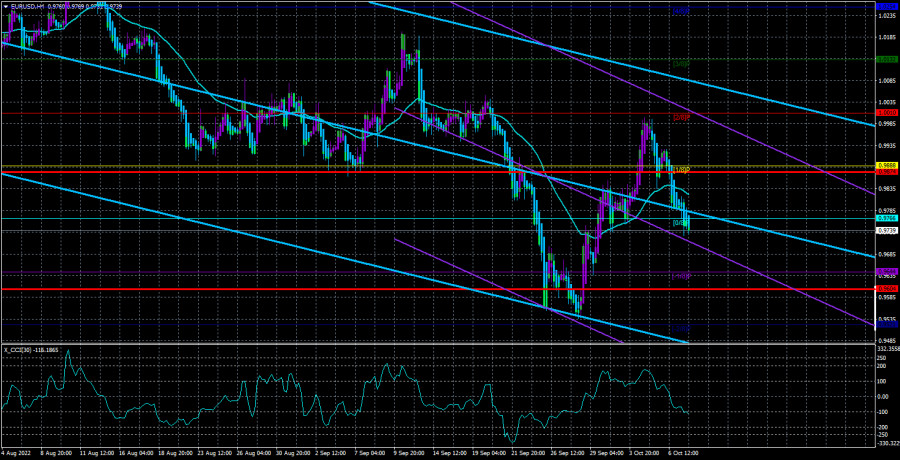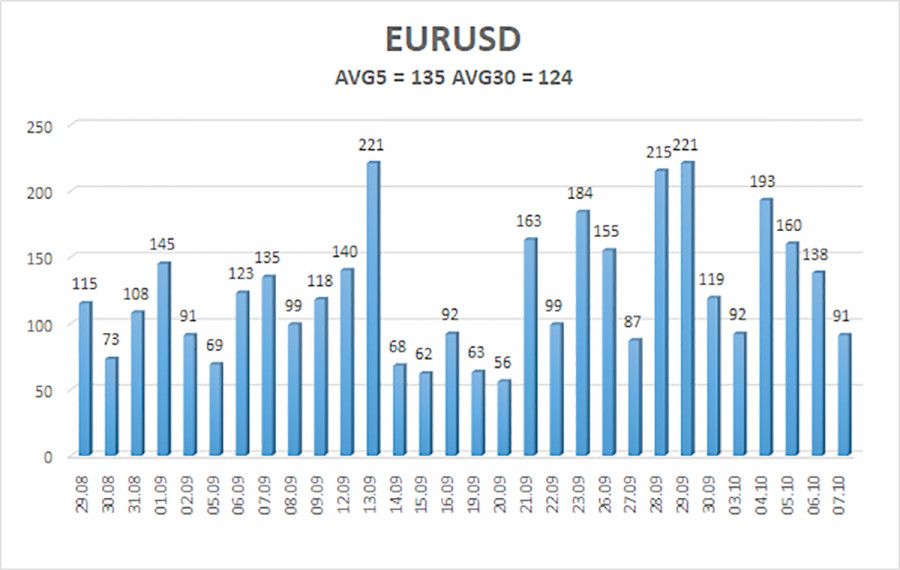

The EUR/USD currency pair was still fixed below the moving average line at the end of Friday. Thus, as we could all get used to, another potential start of a new upward trend ended with the usual correction of 450 points. Of course, this does not mean that it is likely that the pair will now update its 20-year lows once again and will only move down. But unfortunately, the geopolitical background remains such that the markets do not consider risky currencies as a tool that has confidence. Recall that the key news this weekend was the undermining of the Kerch Bridge. At the same time, not because of the APU missile attack but because of the truck explosion on the bridge itself. It is obvious that it did not explode by accident, and a passing locomotive with fuel next to it, too. But at the same time, this situation looks more like undermining the "Northern Streams" than an obvious military attack. It is still unclear who is behind this diversion, and there are many versions, as usual. So far, it's difficult to say what happened and how a truck with explosives could pass through checkpoints. However, it is not even important to us, but the fact that the escalation of the military conflict between the West and the Russian Federation is intensifying. And this means that it will not get better in the near future. It will be worse.
From a technical point of view, all hopes of a 24-hour TF collapsed last week. The euro currency quickly returned to the area below the critical line, so everything will ensure that the downward trend will continue. The fundamental background in the current circumstances is fading into the background. However, it does not support the European currency either. The problem with gas in Europe has not gone away, and the problem with high energy prices and high inflation has not gone away either. Therefore, if the "foundation" has not deteriorated, it has not improved. If the same "foundation" has contributed to the fall of the euro in the last 7-8 months, then why should it be supported now? There was a small hope that the bears had just enough of the euro sales, but, as we can see, it is not destined to come true yet.
Regardless of inflation, the Fed will raise rates several times.
As the article's title suggests, the most important report of the next week will be inflation in the United States. It should be noted that experts do not expect a strong slowdown in September. Forecasts range from 8.1 to 8.2%, with an August value of 8.3%. As we said two months ago, one strong decline in the consumer price index does not mean that inflation will now fall by 0.5-0.6% every month. The last report showed its slowdown by only 0.2%, and the new one may show even less. Therefore, the Fed should not ease the "monetary pressure" and should continue to raise the rate. We do not believe that, for any reason, the Fed will abandon its aggressive approach. We believe that another 1.25% will increase the rate at the remaining two meetings, and maybe we will see another 1-2 increases in 2023. This means that monetary policy will continue tightening, stimulating the market to buy US currency. The ECB is far behind. He has also started to raise the rate and will move to an aggressive approach. But it will take at least six months before the Fed and ECB rates can at least get closer to each other. All this time, the dollar will be preferable for purchases.
Among other events and reports, we will highlight another speech by Christine Lagarde, whose rhetoric is unlikely to change. The report on industrial production in the European Union hardly interests anyone now. And no more important events and publications are planned in the EU. Therefore, geopolitics will again play a greater role. In particular, everyone is now waiting for an official statement from the Kremlin regarding what happened on the Kerch Bridge.

The average volatility of the euro/dollar currency pair over the last 5 trading days as of October 10 is 135 points, which is characterized as "very high." Thus, we expect the pair to move between the levels of 0.9604 and 0.9874 on Monday. A reversal of the Heiken Ashi indicator back to the top will signal a round of upward correction.
Nearest support levels:
S1 – 0.9644
S2 – 0.9521
Nearest resistance levels:
R1 – 0.9766
R2 – 0.9888
R3 – 1.0010
Trading Recommendations:
The EUR/USD pair has consolidated below the moving average line. Thus, it is necessary to stay in short positions with targets of 0.9644 and 0.9604 until the Heiken Ashi indicator turns upwards. Purchases will become relevant again no earlier than fixing the price above the moving average with goals of 0.9888 and 1.0010.
Explanations of the illustrations:
Linear regression channels help to determine the current trend. The trend is strong if both are directed in the same direction.
The moving average line (settings 20.0, smoothed) – determines the short-term trend and the direction in which trading should be conducted now.
Murray levels are target levels for movements and corrections.
Based on current volatility indicators, volatility levels (red lines) are the likely price channel in which the pair will spend the next day.
The CCI indicator – its entry into the oversold area (below -250) or into the overbought area (above +250) means that a trend reversal in the opposite direction is approaching.